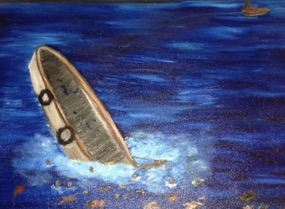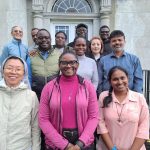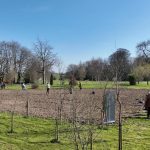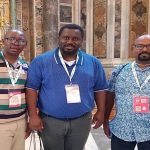https://www.rte.ie/player/series/mass-on-sunday/SI0000003570?epguid=IH000378843
In my life it was a great privilege to work as a missionary in Ethiopia for eleven years. I ministered in a prison for six of those years. One of the projects that we started was a way for prisoners to express themselves through painting. It was always a great joy to watch the artists at work and a privilege to see that through their art they engaged with their prison world. Art also allowed them to engage with issues outside the prison. Migration was one such issue.

I watched the above painting being created and it left me with a great appreciation for the artist and his work. The artist is TesfaMichael Yohannes. Now out of prison, he works full-time as a painter. When he was a prisoner with his own challenges and concerns, TesfaMichael still had a big heart for others, especially mindful as he was of friends and neighbours who were leaving Ethiopia to seek a better life in far-off places. The title of his painting, “Dying to get to Europe” shocked me as indeed the painting did then and continues to do.
The artist was conscious of the perilous journeys of so many migrants crossing the Mediterranean trying to get to Europe. In the painting, the boat has capsized and it is possible to see the outlines of the people who are drowning. In the far-right corner another boat is moving away. This was the boat of the traffickers, the ones who are themselves safe and who get to keep the money given by those who are drowning. The painting provides stark and troubling images. It is a reminder of the suffering of others, their vulnerability and their pain.
I show the painting to remind myself that, as I speak, all over the world there are people on the move; people experiencing hunger and thirst; people encountering suspicion and hostility; people risking all in the hope of finding a place to be safe. I show the painting to honour those who do so much to welcome the stranger, to provide care and support to those most in need. I show the painting to remember the dead, those lost along the way to a better tomorrow. I show the painting to remind myself of the privileges that I enjoy as an Irish citizen; others are not so lucky. I show the painting to remember why people have to leave their homes in the first place.
The stories of the people in the painting are the tales of ordinary folk from many nations fleeing war, civil unrest, ethnic conflicts, grinding poverty. They are people who were being persecuted and tortured because of what they believe, because of their gender, because of their sexual orientation, because of their race or political persuasion. I show the painting to remind myself that, thankfully, many people do survive that perilous sea-crossing. For them it is the first part of a long journey that eventually ends at our shores.
Today we celebrate the Feast of the Baptism of the Lord. Jesus hears the words ‘You are my Son, the Beloved; my favour rests on you’. It is an amazing affirmation of both Jesus and his mission. It’s as if God is saying to him ‘I love you and I want you to bring the good news to the poor so that they may know they are loved greatly. I want you to free people from whatever imprisons them, to heal people in mind and body and spirit – this is your mission’.
Spirasi, the asylum-seeker initiative of the Spiritan (Holy Ghost) Congregation, has for 20 years been involved in welcoming people who have sought asylum from persecution and torture, many of whom have made that same perilous journey depicted in the painting to eventually reach Ireland. The welcome is the first part of the rehabilitation – the healing that Spirasi offers.
The second part of this rehabilitation, of this healing, is the skills that the physicians, therapists and psychosocial workers bring to each person. But it is not just the specialist skills that they bring. It is the way in which these skills are used. Each psychotherapist, each physician, each psychosocial worker brings their compassion, their empathy and a willingness to really listen to the person in front of them. Both their skills and the way in which those skills are used contribute equally to the healing that takes place.
I find this consoling, not just because such amazing work is being done, not just because people who have been brutalised are being healed, not just because the ministry of Jesus continues in our world today if we have eyes to see it in Spirasi and elsewhere, but because I too can be part of this healing ministry and you too can be part of this healing ministry. Whenever we welcome the stranger, whenever we act with compassion, whenever we listen to another person’s story with deep empathy – then we become part of the healing process and make this world a better place for all to live in.
As I stand here today, I think of my time in Ethiopia and the welcome that I received there as a stranger, and the many small acts of kindness and support that I experienced which made Ethiopia a real home for me. I think about TesfaMichael, the artist who painted this picture. I think about his compassion and decency. And I think about the work of Spirasi as a sign of hope that even the most horrendous physical, mental and spiritual damage can be healed. Suffering is real but healing is possible.
Reflecting on his four and a half years of captivity in Beirut, Brian Keenan wrote a book called “An Evil Cradling”. In the acknowledgments at the start of the book, the author thanked the people of Westport, Co. Mayo whose “quiet and unobtrusive embrace was a balm beyond measure”. This is a wonderful image of the healing that a community can give.
My prayer is for an Ireland that welcomes the stranger and where we will always have a huge heart for those who have suffered greatly.
May the wounded find shelter, healing and hope and above all a place to call home!
Image by Capri23auto from Pixabay
+






